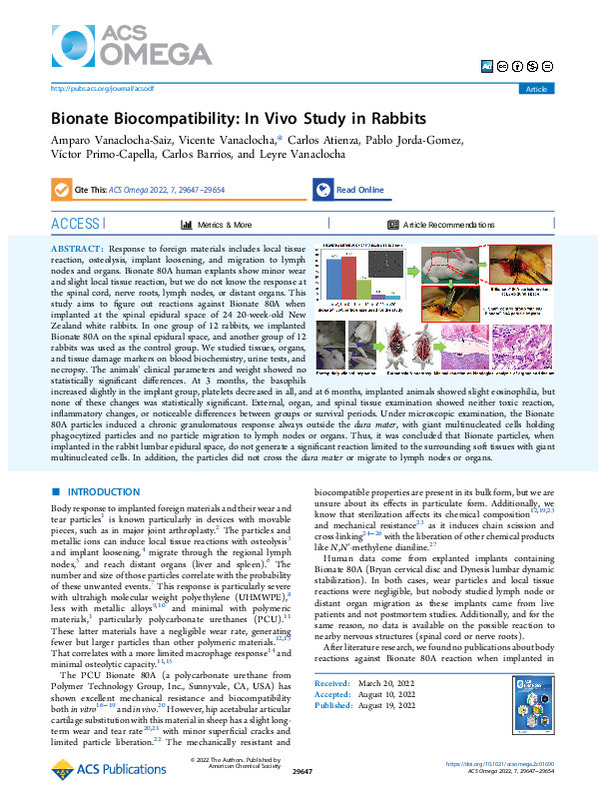JavaScript is disabled for your browser. Some features of this site may not work without it.
Buscar en RiuNet
Listar
Mi cuenta
Estadísticas
Ayuda RiuNet
Admin. UPV
Bionate Biocompatibility: In Vivo Study in Rabbits
Mostrar el registro sencillo del ítem
Ficheros en el ítem
| dc.contributor.author | Vanaclocha-Saiz, Amparo
|
es_ES |
| dc.contributor.author | Vanaclocha, Vicente
|
es_ES |
| dc.contributor.author | ATIENZA VICENTE, CARLOS MANUEL
|
es_ES |
| dc.contributor.author | Jorda-Gomez, Pablo
|
es_ES |
| dc.contributor.author | Primo Capella, Victor
|
es_ES |
| dc.contributor.author | Barrios, Carlos
|
es_ES |
| dc.contributor.author | Vanaclocha, Leyre
|
es_ES |
| dc.date.accessioned | 2023-05-22T18:02:34Z | |
| dc.date.available | 2023-05-22T18:02:34Z | |
| dc.date.issued | 2022-08-30 | es_ES |
| dc.identifier.uri | http://hdl.handle.net/10251/193514 | |
| dc.description.abstract | [EN] Response to foreign materials includes local tissue reaction, osteolysis, implant loosening, and migration to lymph nodes and organs. Bionate 80A human explants show minor wear and slight local tissue reaction, but we do not know the response at the spinal cord, nerve roots, lymph nodes, or distant organs. This study aims to figure out reactions against Bionate 80A when implanted at the spinal epidural space of 24 20-week-old New Zealand white rabbits. In one group of 12 rabbits, we implanted Bionate 80A on the spinal epidural space, and another group of 12 rabbits was used as the control group. We studied tissues, organs, and tissue damage markers on blood biochemistry, urine tests, and necropsy. The animals' clinical parameters and weight showed no statistically significant differences. At 3 months, the basophils increased slightly in the implant group, platelets decreased in all, and at 6 months, implanted animals showed slight eosinophilia, but none of these changes was statistically significant. External, organ, and spinal tissue examination showed neither toxic reaction, inflammatory changes, or noticeable differences between groups or survival periods. Under microscopic examination, the Bionate 80A particles induced a chronic granulomatous response always outside the dura mater, with giant multinucleated cells holding phagocytized particles and no particle migration to lymph nodes or organs. Thus, it was concluded that Bionate particles, when implanted in the rabbit lumbar epidural space, do not generate a significant reaction limited to the surrounding soft tissues with giant multinucleated cells. In addition, the particles did not cross the dura mater or migrate to lymph nodes or organs. | es_ES |
| dc.language | Inglés | es_ES |
| dc.publisher | American Chemical Society | es_ES |
| dc.relation.ispartof | ACS Omega | es_ES |
| dc.rights | Reconocimiento - No comercial - Sin obra derivada (by-nc-nd) | es_ES |
| dc.subject.classification | INGENIERIA MECANICA | es_ES |
| dc.title | Bionate Biocompatibility: In Vivo Study in Rabbits | es_ES |
| dc.type | Artículo | es_ES |
| dc.identifier.doi | 10.1021/acsomega.2c01690 | es_ES |
| dc.rights.accessRights | Abierto | es_ES |
| dc.contributor.affiliation | Universitat Politècnica de València. Escuela Técnica Superior de Ingenieros Industriales - Escola Tècnica Superior d'Enginyers Industrials | es_ES |
| dc.description.bibliographicCitation | Vanaclocha-Saiz, A.; Vanaclocha, V.; Atienza Vicente, CM.; Jorda-Gomez, P.; Primo Capella, V.; Barrios, C.; Vanaclocha, L. (2022). Bionate Biocompatibility: In Vivo Study in Rabbits. ACS Omega. 7(34):29647-29654. https://doi.org/10.1021/acsomega.2c01690 | es_ES |
| dc.description.accrualMethod | S | es_ES |
| dc.relation.publisherversion | https://doi.org/10.1021/acsomega.2c01690 | es_ES |
| dc.description.upvformatpinicio | 29647 | es_ES |
| dc.description.upvformatpfin | 29654 | es_ES |
| dc.type.version | info:eu-repo/semantics/publishedVersion | es_ES |
| dc.description.volume | 7 | es_ES |
| dc.description.issue | 34 | es_ES |
| dc.identifier.eissn | 2470-1343 | es_ES |
| dc.identifier.pmid | 36061708 | es_ES |
| dc.identifier.pmcid | PMC9435029 | es_ES |
| dc.relation.pasarela | S\474432 | es_ES |








